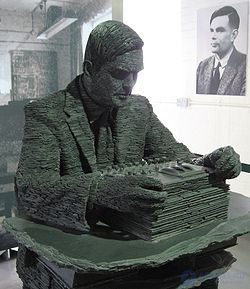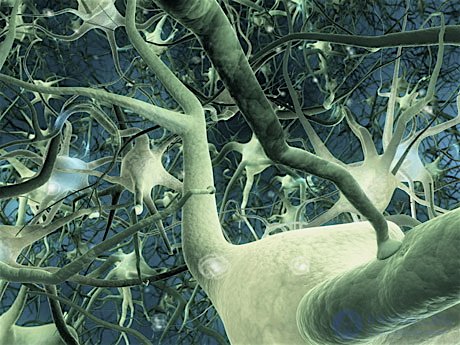Lecture
The dream of iron assistants, which is controlled by artificial intelligence , lived in humanity a long time ago. In the forge of Prometheus , the “iron maidens-assistants” were already working, the clay Golem faithfully served its owner (and came out of obedience when he put the wrong program in his mouth), so the main problems of the AI were predicted even then. But even the really complicated mechanisms didn’t come close to that mysterious process called intellect .
 The formal rules of thinking were developed by Aristotle , and the AI has been successfully used to this day. Already in the Middle Ages, people realized that this process was formally analogous to calculations . Amazingly, for a long time, the brain was not at all considered the focus of intelligence. Even the spleen was considered as such.
The formal rules of thinking were developed by Aristotle , and the AI has been successfully used to this day. Already in the Middle Ages, people realized that this process was formally analogous to calculations . Amazingly, for a long time, the brain was not at all considered the focus of intelligence. Even the spleen was considered as such.
Only the achievements of biology , medicine, and psychology of the late 19th and early 20th centuries accurately determined where the intellect is located. But only the emergence of cybernetics in the middle of the 20th century once again revived the hope that thinking processes can be modeled and, possibly, improved. The solution of the question seemed so close that the question of how to distinguish artificial intelligence from natural was seriously discussed. It was then that was invented by a wonderful English mathematician.

Alan Turing test of intelligence, bearing his name. It was designed to distinguish between types of intelligence and suggested that if, when communicating with an invisible interlocutor, a person cannot determine whether a person is his interlocutor or artificial intelligence, then such a computer should be considered as having an artificial intelligence.
The past 50 years have not reduced the value of the test for AI , invented by Turing, but found its fundamental flaw. Now there are a lot of software bots that completely satisfy this test, but the fact that they have an artificial mind is never discussed. They wonderfully successfully imitate natural intelligence, but they really are not. So, the priority task of modern research in the field of AI has become a deep study of the processes of thinking, and not its imitation.
The Japanese once again decided to surprise the world and created a robot capable of learning. In this video, he performs a simple action - pours water from a bottle into a glass. The researcher complicates the task and asks the android to cool the water. This is where the fun begins. The robot does not know how to cool the water. It does not contain such a program. Using his basic knowledge, he puts the bottle in, takes an ice cube and puts it in a glass. Analysts say - this is the first step towards the emergence of artificial intelligence.
And it turned out that it is extremely difficult to define this phenomenon - the intellect. Just say that "Artificial intelligence is ..." no one can yet. But without such a definition, any effort to create artificial intelligence turns into unsystematic throwing. Moreover, among scientists there is also the opinion that intelligence can only have a biological nature. And if so, then attempts to create artificial intelligence using non-biological objects are doomed to failure.
One of the main issues that must be addressed when creating an AI is about the mechanism of knowledge . The first model, called the "Universal Solver", was not so much to even find the right answer, but to go through the stages characteristic of human thinking. Already this simple, according to current concepts, the program has brought closer to answering the question about the types of intelligence.
Another kind of intellect, based on the laws of formal logic , suggests that the correct assumptions will always be drawn from the right premises . The trouble is that the achievement of complete rationality in the real world is unattainable, and, therefore, the practical implementation of this type of intelligence is faced with incredible difficulties. After all, artificial intelligence is not just a set of rigid algorithms , but something else.
To some extent, these two approaches are combined with the idea of a rational agent, that is, an algorithm that is focused on achieving the desired result in any way it can. Such a model is considered today the most promising for creating an artificial mind.
Since the 80s of the last century, artificial intelligence has become the object of production. The first successful commercial system using AI is considered to be R1, introduced by the computer company DEC , and saving it about $ 40 million a year. From this point on, the perspective of using artificial intelligence became clear to everyone. The artificial intelligence implemented today, the news about which is heard every day, is not, in fact, a mind in the full sense of the word, but it already provides people with many services . Finally, scientists realized that artificial intelligence is not an imitation of the natural. There is no need to make a copy of a biological object if people already do not use the power of the brain at best by half; the overwhelming majority of humanity spends its intellect on fruitless efforts to survive. But the rapid growth of companies that investigated and produce artificial intelligence, stopped at the turn of the century. Theory has exhausted itself, and new breakthroughs in the creation of artificial intelligence has not come. Scientists returned to the neural networks , seeing in them a new opportunity to create an artificial mind. In recent years, significant steps have been taken along this path. The learning algorithm was rethought, and the creation of artificial intelligence moved from its place.

Finally, artificial intelligence has become a science . He uses exact theorems and gets experimental results, like any other scientific discipline . The era of insights and guesses is over, there is a systematic attack on artificial intelligence. More and more areas of economics and science are using artificial intelligence, news about this is heard more and more often. Even in the computer on which this text is typed , there are several AI systems, Microsoft uses them to diagnose equipment and promptly troubleshoot problems. Similar upheavals have occurred in other areas related to IT .
Autonomous planning and calculation of trajectories and plans. NASA’s Remote Agent program calculates the spacecraft motion graphs.
Games. IBM's Deep Blue program won the match against world chess champion Garry Kasparov . After the match, he said that he was faced with a new kind of intelligence.
Autonomous control. The Alvinn artificial vision system was trained in car driving. A minibus under its control traveled through the territory of the United States 4 and a half thousand kilometers, the driver took control only during difficult ramps from ramps , artificial intelligence had not yet mastered this obstacle, which was no more than 2% of the time. No accidents or violations were not.
Medical diagnostics. In some areas of medicine, programs using the principles of AI have reached the level of an experienced physician. For example, a program that uses artificial intelligence, the news about which was heard recently, managed to convince a well-known diagnostician whose opinion was the opposite.
Planning. The war in the Persian Gulf brought to life artificial intelligence, which controlled 50 thousand units of equipment, which provided the army with supplies. The system planned transportation and fixed problems, making plans as quickly as anyone else.
Robotics. The use of robot assistants with AI in microsurgery has already become familiar. Including innovative motoman solutions in the field of automation of robotic products for virtually every industry, including electric arc welding, assembly, coating, cutting materials (laser, plasma water jet), material processing (casting, loading, packaging, palletizing), material removal (tumbling, polishing, grinding) and spot welding.
Understanding of natural language and solving related problems. Artificial intelligence already exists, solving crossword puzzles faster and better than people, recognizing unfamiliar concepts.
Further paths of development and creation of an artificial mind of a new species lie in the development of genetic algorithms that penetrate the deepest secrets of biological systems. Here, AI is built on the principles of genetic evolution , abstracting from the task itself, exploring the quality of new generations of solutions formed according to the rules of genetics . From this direction, apparently, artificial intelligence is news and will generate in the greatest quantity all coming years.
Comments
To leave a comment
Artificial Intelligence. Basics and history. Goals.
Terms: Artificial Intelligence. Basics and history. Goals.